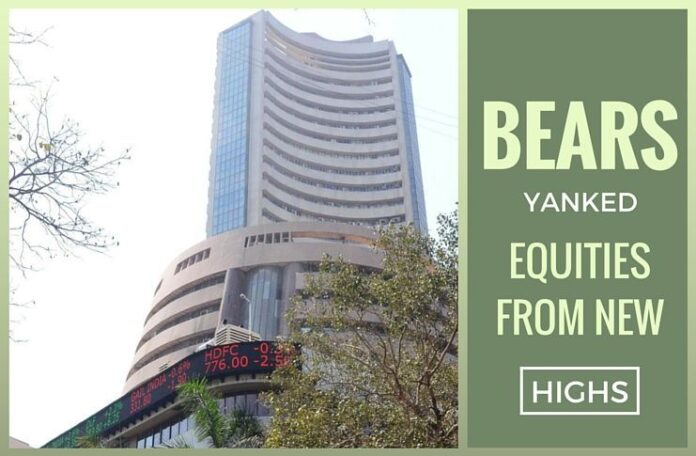
Mumbai
[dropcap color=”#008040″ boxed=”yes” boxed_radius=”8px” class=”” id=””]I[/dropcap]n what was a dramatic year for the Indian stock markets, key indices scaled record highs, only to see their valuations drop sharply over the months. As a result the two most quoted indices – the 30-scrip sensitive index (Sensex) of the S&P Bombay Stock Exchange (BSE) and the 50-scrip Nifty of the NSE fell by 5.00 percent, 4.1 percent, respectively.
In comparison, the two indices had logged gains of 29.89 percent (Sensex) and 31.38 percent (Nifty) in 2014 to emerge as best performers globally.
The Sensex was amongst the worst performing benchmarks in the BRICS nations. Russia-based bellwether index was the best performing with growth of 26.1 percent, while Brazil’s benchmark was the biggest loser with an approximately 13.3 percent plunge during 2015.
[dropcap color=”#008040″ boxed=”yes” boxed_radius=”8px” class=”” id=””]”W[/dropcap]e saw a strong rally in 2014 led by the results of the general elections and expectations of a strong government,” Vaibhav Agarwal, vice president and research head at Angel Broking, told IANS.
“This year was a period of consolidation, laying the foundation for a strong up move in the coming months.”
Devendra Nevgi, chief executive of ZyFin Advisors elaborated that: “Lack of major reforms, weaker global growth including China) and tepid domestic growth and the ensuing poor earnings. Political stalemate was the key too”.
[dropcap color=”#008040″ boxed=”yes” boxed_radius=”8px” class=”” id=””]A[/dropcap]ccording to stock markets data among individual stocks that comprise the 30-share Sensex, Maruti Suzuki gained the most, by 38.7 percent; followed by Lupin, up 28.7 percent and Asian Paints, up 17.6 percent.
At the other end of the spectrum, BHEL was the worst performer, down 36.2 percent, followed by Tata Steel, down 35 percent, and ONGC, down 29.1 percent.
Sector-wise the S&P BSE consumer durables was the best performer (24 percent), followed by healthcare (15.1 percent) and information technology (IT) (4.5 percent).
[dropcap color=”#008040″ boxed=”yes” boxed_radius=”8px” class=”” id=””]B[/dropcap]ut, the metal indice plunged by 31.2 percent, the realty index receded by 13.6 percent and the banking index declined by 9.9 percent.
During the year, the Sensex scaled an intra-day high of more than 30,000 points on March 4, when it touched 30,024.74 points, while the Nifty saw its own high on the same day at 9,119.20 points.
Both touched their record lows of 24,833.54 points and 7,539.50 points on September 8 2015.
[dropcap color=”#008040″ boxed=”yes” boxed_radius=”8px” class=”” id=””]”T[/dropcap]he year 2015 wiped off almost half of 2014’s gains, which does not quite illustrate the fact that 2015 was decidedly bearish, with each of the attempts to rise being eclipsed by even bigger falls,” Anand James, co-head, technical research desk with Geojit BNP Paribas Financial Services, told IANS.
One of the main reasons for such a rout from an all-time high was the unpredictability of foreign funds, which were net sellers as opposed to net buying of equities worth $16.11 billion in 2014.
Figures from the National Securities Depository Limited (NSDL) showed that the FPIs (Foreign Portfolio Investors) bought stocks and debt worth Rs.63,663 crore in 2015 from its previous year’s levels that exceeded Rs.1 lakh crore.
[dropcap color=”#008040″ boxed=”yes” boxed_radius=”8px” class=”” id=””]T[/dropcap]he NSDL data showed that the FPIs were net buyers of equities worth Rs.17,808 crore ($2.68 billion) in the year gone by. “The FPI flows this year could be lower given the developments in US and the poor macro situation of other EMs. Reforms are the key to foreign flows,” Nevgi cited.
What, perhaps, salvaged the situation to a large extent was the buying activity by the DIIs (domestic institutional investors) which, on many occasions, fully countered the pull-out by FPIs.
The data with stock markets showed that DIIs were net buyers of equities worth Rs.67,586.82 crore ($10.17 billion) during the just-concluded year.
“Clearly the pull out of funds did have some impact on the market performance. However, the same was mitigated to some extent by the DIIs who continued to invest in equities as the fundamental story for the country remains strong,” said Nitasha Shankar, Vice President – Research, YES Securities.
[dropcap color=”#008040″ boxed=”yes” boxed_radius=”8px” class=”” id=””]A[/dropcap]nother positive surprise was that more IPOs were listed in 2015 than in previous years. “Most of them rewarded investors handsomely too, with as much as 30 percent of the IPOs registering an over 50 percent jump over the listing price, by end of year,” James said.
In addition, small caps out performed the big guns. Analysts attributed the stellar performance of small caps to their limited exposure to FPIs than large caps.
The S&P BSE mid-cap rose by 7.4 percent, while the small-cap gained 6.8 percent.
“One of the major reasons has been the run up in mid and large caps that unfolded during 2014 that made them relatively more expensive for investment in 2015, despite the price falls,” James added.
[dropcap color=”#008040″ boxed=”yes” boxed_radius=”8px” class=”” id=””]A[/dropcap]part from the positives, the year went by with nervous sentiment till the second week of December, when the US Federal Reserve raised benchmark interest rates after a decade of near zero levels.
The other key event was the Chinese slowdown, which market observers pointed-out as the root cause for crash of commodity prices.
“Two events that had the most profound impact on markets were the expectations on increase of interest rates by the US Fed and the emerging signs of slowdown in China that brought back concerns over global economic growth,” Shankar said.
James explained: “While US Fed’s rate hike did have a major impact, the defining event certainly has been the slowdown in Indian reform momentum, or in other words, the bursting of the bubble of high expectations.”
Highlights:
- Sensex fell by 5 percent
- Nifty was lower by 4.1 percent
- Maruti Suzuki was best performing Sensex stock
- BHEL was the worst performing Sensex stock
- Consumer durable was the best performing sector
- Metal was the worst performing sector
- Mid-cap gained by 7.4 percent
- Small-cap rose by 6.8 percent
Note:
1. The conversion rate used in this article is 1 USD = 66.43 Rupees.
(IANS)
- Subramanian Swamy approaches Supreme Court on Govt’s modification of 2G Scam Judgment to avoid auction of Satellite Spectrum - April 23, 2024
- Defence Minister Rajnath Singh visits Siachen. Reviews military preparedness - April 22, 2024
- Amit Shah’s shares in the Stock Market almost doubled in the past five years - April 21, 2024










